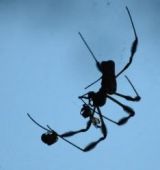- Forum
- General Discussion | Introductions | Off Topic Forum
- Photography General Discussion
- Macro shots with lenses reversed?
Macro shots with lenses reversed?
-
 Topic Author
Topic Author
- SJM
- Photography Hooked
-
- Nikon D300
- Followers: 120
- Posts: 563
-
Points:
2433
Post #153780
If not primes, what lenses (Nikon) can be reversed for macro?
Country guy living in the big Apple!
Post #153786
What was in those brownies??? Are there any more left?
“Amateurs worry about equipment, professionals worry about money, masters worry about light, I just make pictures… ” ~ Vernon Trent
-

- Dori
- Moderator
-
- Nikon D5000
- Followers: 167
- Posts: 7371
-
Points:
12
Post #153806
Don't pi$$ me off, I am running out of room to store the bodies...
Resident Texasotan...
-

- cod
- Snapobsessed
- Nikon D300S
- Followers: 71
- Posts: 484
-
Points:
1165
Post #153857
Theoretically, at magnifications greater than life-size, a short focal length lens should give better image quality too. The lens is designed to work best when the lens-to-subject distance is greater than the lens-to-sensor distance. At high magnifications with a lens mounted on extension tubes this is not the case and reversing the lens restores the best ratio.
All my sources say to use primes, not zooms, but I'm having trouble finding much explanation of why. Here's one guy who says he has good results with a reversed zoom but I don't know what his standard of "good" is. Short primes tend to be a very good optical quality, better than zooms, so there's one argument for primes. Depending on your point of view, since focusing involves moving the whole camera, the added variable of varying focal length with zooms could be viewed as a benefit or a complication.
In reversing a lens you lose all connections to the camera, auto-focus (not that you need that at high magnification), exposure, etc., so any good prime should be fine. It doesn't have to be your camera brand, but it does need to have an aperture ring, which many modern lenses don't have. I'd tend to look for an old manual focus lens of high quality which should be cheap on eBay and sim if I didn't already own a suitable lens.
-
 Topic Author
Topic Author
- SJM
- Photography Hooked
-
- Nikon D300
- Followers: 120
- Posts: 563
-
Points:
2433
Post #153935
Such good answers, thank you all for helping me out with this question.
Country guy living in the big Apple!
Post #154064
SJM wrote: That is interesting, I'm curious why reversing lenses under 100mm are better than reversing something larger. So let's say you have a 105mm with extension tubes, will you get closer to your subject with this or a 50mm reversed?
Such good answers, thank you all for helping me out with this question.
It may be harder to control the lens, the aperture with longer lenses. I don't know.
-

- cod
- Snapobsessed
- Nikon D300S
- Followers: 71
- Posts: 484
-
Points:
1165
Post #154294
SJM wrote: That is interesting, I'm curious why reversing lenses under 100mm are better than reversing something larger. So let's say you have a 105mm with extension tubes, will you get closer to your subject with this or a 50mm reversed?
Such good answers, thank you all for helping me out with this question.
It's been a long, long time since I've used a prime + extension setup. I now use dedicated macro lenses but am considering trying my hand at high magnification pics again, so you've tweaked my interest with this question. The "why" is definitely hard to come by.
When using extension (lens not reversed), magnification = extension/focal length, according to John Shaw's classic Closeups in Nature . When a 105 mm lens is used at 1:1 then there is essentially 105mm of extension built into the lens. To get twice life-size magnification you need to add another 105mm of extension. that's a lot of extension. Higher magnifications at longer focal lengths require rather unwieldy combinations. Supporting the combo and keeping the setup steady becomes a challenge. Shorter lenses can achieve higher magnification with less extension and are more managable. I suspect a similar argument is true for reversed lenses, though the numbers will be different.
I've been thinking of using a reversed lens on extension tubes. Another option is to use a reversed lens as a high quality diopter/close-up filter stacked on another lens. That's a different issue.
-

- Screamin Scott
- Moderator
-
- Nikon D610, Nikon D7100, Nikon D300, Olympus OMD E-M5 MarkII, Olympus OM-D E-M10, Olympus Pen E-P3 + film SLR's
- Followers: 1384
- Posts: 6866
-
Points:
40251
Post #154320
- Forum
- General Discussion | Introductions | Off Topic Forum
- Photography General Discussion
- Macro shots with lenses reversed?
Latest Reviews
The Olympus Pen E-P7 is an affordable micro four thirds mirrorless camera with 4K video capabilities, a 20.3MP sensor, and 121 focus points, making it a solid entry-level camera for beginners.
The Panasonic G9 II is a 25.2-megapixel micro four thirds camera with numerous features that make it punch out of its weight class, like 779 AF points, 5.8K video, and weather sealing.
The Fujifilm XT5 is a 40MP mirrorless camera capable of 6.2K video at 30p. With those specs, it’s an ideal choice for photographers needing a camera to pull double duty for imaging and video.
The Canon EOS R100 is an entry-level mirrorless camera introduced in 2023. But just because it’s an entry-level camera doesn’t mean it’s a bare-bones camera. Find out why in this review!
Forum Top Posters
-
1Scotty 7 posts
-
2Roman Omell 4 posts
-
3Razky 4 posts
-
4Ruby Grace 3 posts
-
5Pat White 3 posts
-
6Nefarious 3 posts
-
7ShutterPal 3 posts
-
8Roger Lang 3 posts
-
9Jim Photo 3 posts
-
10CharleyL 3 posts
Latest Articles
In this guide to the bokeh effect, you’ll learn what bokeh is and the factors involved in creating it. You’ll also explore some beautiful example images to spark your creativity with bokeh!
Upgrade your kit in 2024 with the best intermediate camera on the market! The question is, what camera fits the bill? We’ve got three top options for you to choose from in this buyer’s guide.
The best photography jobs right now are a mix of tried-and-true gigs like wedding photography and new jobs highlighting AI’s capabilities, travel, and videography.
The Olympus Pen E-P7 is an affordable micro four thirds mirrorless camera with 4K video capabilities, a 20.3MP sensor, and 121 focus points, making it a solid entry-level camera for beginners.
Starting a photography business is one thing; sustaining your business over a long period of time is another. Use the tips in this professional photography guide to build something with longevity!
The Panasonic G9 II is a 25.2-megapixel micro four thirds camera with numerous features that make it punch out of its weight class, like 779 AF points, 5.8K video, and weather sealing.
Cinematic photography is an interesting genre that combines photographic and videographic skills along with effective storytelling techniques. The result? Highly impactful images!
Newborn photography requires skill, the right gear, and a lot of patience. This beginner’s guide discusses critical topics that will help you be more prepared for before, during, and after the shoot.















